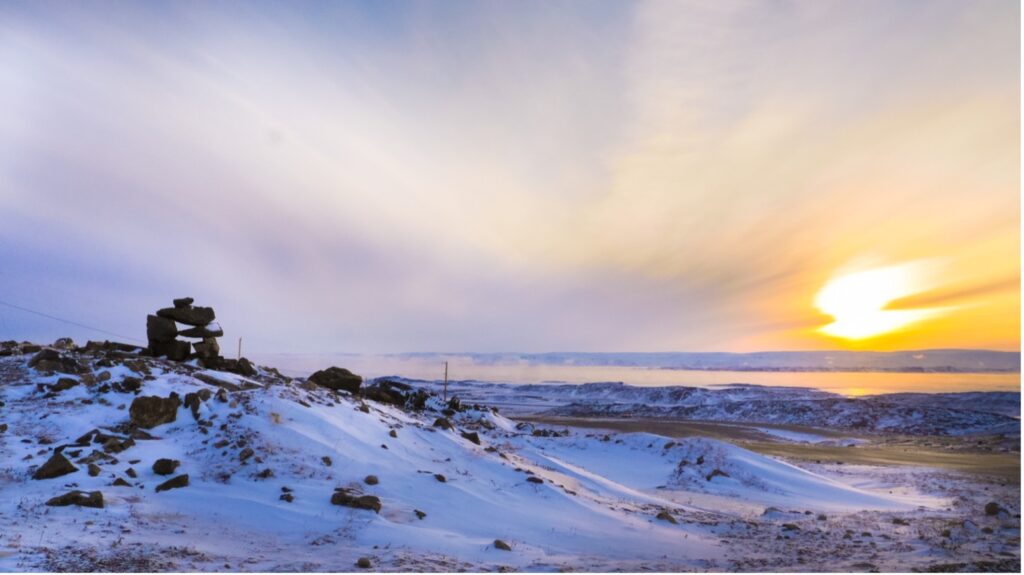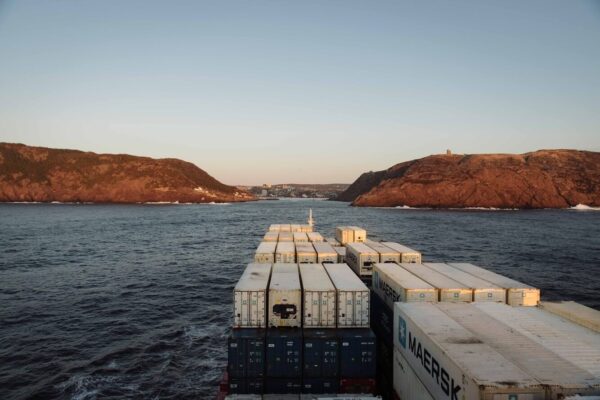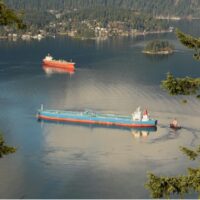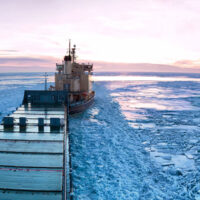Clear Seas convenes a roundtable to gather perspectives on the use of LNG as fuel for marine shipping in Canada’s north.
A recent virtual workshop looking at the feasibility of a liquefied natural gas (LNG) supply chain in the Canadian Arctic, hosted by Clear Seas Centre for Responsible Marine Shipping, brought together speakers representing a range of opinions and perspectives from the Inuit homeland, government, industry, shipping, and environmental non-governmental organizations.
The event was part of a study currently being conducted by Clear Seas, the Canadian Natural Gas Vehicle Alliance, and Vard Marine, and funded by Transport Canada’s Innovation Centre, to investigate the feasibility, benefits, and risks of the use of LNG to replace some or all the diesel and heavy fuel oil (HFO) used for shipping and other needs in the Canadian Arctic. This switch could reduce greenhouse gas emissions by up to 25%, and other criteria air contaminants, such as particulate matter and carbon monoxide, by 80% or more.
In her introductory comments, Meghan Mathieson, Director of Strategy and Innovation at Clear Seas and moderator of the two-day event, noted the urgency of the conversation and the need for the study. “The Arctic is warming, and fuel choices are having an impact,” she told the 40 participants and presenters who came from as far away as New Zealand, bringing perspectives from Western science and Traditional Knowledge to the table.
Lisa Koperqualuk, Vice-President, International Affairs at the Inuit Circumpolar Council of Canada (ICC), set the stage by identifying the potential impacts of an increase in shipping traffic: increased risk of fuel spills, underwater noise and introduction of invasive species from ballast water.
She emphasized that Indigenous Peoples need to be present at the table when stakeholders in international shipping meet to talk about issues like decarbonization and increased marine traffic — based on thousands of years of habitation by Inuit in the region. This perspective is why ICC Canada applied for and received provisional consultative status at the International Maritime Organization. They are the first Indigenous organization to gain this standing and sought it due to their awareness of the threats from international shipping to their way of life.
Arctic shipping directly affects Inuit way of life
Koperqualuk sees the expansion of marine shipping in the Arctic and the continuance of Inuit way of life as a balancing act and drew two important distinctions in the discussion. On the one hand she says: “For shipping companies and cruise lines, the rapid opening of the Northwest Passage is not a threat. It’s an opportunity. The idea for reducing travel time between Asia and Europe is enticing. And it will bring economic benefits for these companies.” At the same time, the Inuit way of life, health and source of food depends on a healthy environment. “How can Arctic shipping as critical infrastructure support the overall health of the Arctic? The people, the flora, the fauna, and the ecosystem? And perhaps, how can it help the planet?” The search for an optimal fuel is a key part of this conversation. For the Inuit, “We are a maritime people. We rely on free movement, first and foremost to eat since so much of our diet is derived from hunting,” she said.
She noted that while regulations exist within Canada and the circumpolar Arctic through the Polar Code and, internationally, through the UN Convention on the Law of the Sea (UNCLOS), enforcement is difficult in this vast and remote space especially with new actors increasingly present, attracted by growing ice-free waters. “Shipping in Inuit Nunangat, the circumpolar Inuit homeland, has increased by 25% since 2015. In Inuit Nunavut, what we all know as the Canadian Inuit homeland, Arctic shipping has increased by 37% between 2015 and 2019. These increases concern us since most of the Arctic fleet still uses heavy fuel oil banned since 2011 in Antarctic waters,” she said.
She echoed concerns of other speakers, noting that heavy fuel oil produces black carbon, which increases ice melt when it is deposited on snow and ice. “All agree that higher temperatures driving increasing and new forms of maritime activity pose serious risks to Inuit and to the marine environment upon which we depend for sustenance,” she said.
Is LNG a substitute for heavy fuel oil?
Koperqualuk says that the central question which remains for her community: Is LNG a better substitute for heavy fuel oil? Her answer defines the dilemma facing the marine industry, along with the Arctic and its inhabitants as a whole: “The bottom line is we want the safest, cleanest, least damaging fuel source to be used in the Arctic. This includes direct impacts like spills and black carbon, as well as impacts globally like methane emissions. But fuel is needed to get the goods we need and to connect us to the rest of the country. The ICCs’ position is that governments must support a safe Arctic shipping fleet and support the transition to clean, safer fuels,” she says.
Ships in the Arctic have an impact beyond the water
Presenters from all points of view all agreed on one thing: marine shipping in the Canadian Arctic has seen dramatic changes over the past few decades. In fact, it has seen an almost tripling of the distance traveled by ships between 1990 and 2015. Dr. Nicolien van Luijk, of the University of Ottawa, who has studied the health and environmental impacts of Arctic shipping, noted that there’s also been large increases in different types of vessels. “For example, pleasure craft were quite rare in the 1990s, but by 2011, the total distance traveled has increased by more than 20 times. And there’s a few other ship types, such as bulk carriers, and passenger ships that have seen some increases as well.”
van Luijk echoed the view of Koperqualuk that while there is still a relatively small number of ships in the region, “…once we talk about the potential impacts of shipping on communities, you begin to understand that even one ship can have a significant impact on the livelihoods of Inuit and local communities. And that’s why it’s important not to underestimate the potential impacts that ships can have on the communities.”
Residents have raised serious concerns related to the impacts of marine shipping on essential harvesting activities. While pollution and the discharge of waste is a clear concern, noise from icebreaking and wake disturbance affecting animals and harvesters alike, and can also affect migration and cause thinning in some wildlife populations. “All of these issues combined can then impact the food security, the health and well-being, the economic security and culture in northern communities for hunting and harvesting, which is integral to their livelihood,” she says.
Jacqueline Kidd of the Inuit Tapiriit Kanatami, previously known as the Inuit Tapirisat of Canada, which represents more than 65,000 Inuit across Inuit Nunangat and the rest of Canada, was also in attendance. Their mission is to “serve as a national voice protecting and advancing the rights and interests of Inuit in Canada.”
Producing a final report
The workshop involved nearly nine hours of discussion and heard important feedback to allow the study’s authors to work toward a concluding report in mid-2022. This includes continuing assembling a series of working groups for sustained engagement. In his concluding remarks, Paul Blomerus, Executive Director of Clear Seas, told the group that “Clear Seas and its partners look forward to putting together something that represents all of the inputs we’ve had. So, thank you, everybody, for your discussion, consideration and your help.”
About the workshop
Drawing on a panel of experts from a range of organizations and backgrounds including government, industry, Indigenous organizations and environmental NGOs, this workshop provided an opportunity for participants to learn about the current state of Arctic shipping, explore the case for banning heavy fuel oil in the Arctic, and understand the potential risks and benefits of LNG in the Arctic. This workshop also gave an overview of work completed thus far in the Arctic LNG Feasibility Study with an opportunity for all participants to share their knowledge and insights on the topic and related issues.
To learn more about the workshop, watch the recordings and view the presentations, visit the project page here.



